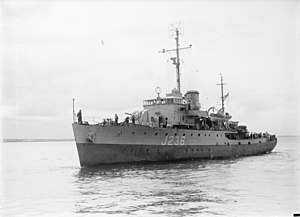HMAS Glenelg (J236)
 HMAS Glenelg
| |
| History | |
|---|---|
| Namesake | Town of Glenelg, South Australia |
| Builder | Cockatoo Island Dockyard |
| Laid down | 2 March 1942 |
| Launched | 25 September 1942 |
| Commissioned | 16 November 1942 |
| Decommissioned | 14 January 1946 |
| Motto | "Staunch In Defiance" |
| Honours and awards | list error: <br /> list (help) Battle honours: Pacific 1942-45 New Guinea 1943-44 |
| Fate | Sold for scrap in 1957 |
| General characteristics | |
| Class and type | Bathurst class corvette |
| Displacement | 650 tons (standard), 1,025 tons (full war load) |
| Length | 186 ft (57 m) |
| Beam | 31 ft (9.4 m) |
| Draught | 8.5 ft (2.6 m) |
| Propulsion | triple expansion engine, 2 shafts |
| Speed | 15 knots (28 km/h; 17 mph) at 1,750 hp |
| Complement | 85 |
| Armament | list error: <br /> list (help) 1 x 4-inch gun 3 x Oerlikons Machine guns 4 x depth charges chutes 2 x depth charge throwers |
HMAS Glenelg (J236/M236), named for the city of Glenelg, South Australia, was one of 60 Bathurst class corvettes constructed during World War II, and one of 36 initially manned and commissioned solely by the Royal Australian Navy (RAN).[1]
Construction
Glenelg was laid down by the Cockatoo Island Dockyard at Sydney, New South Wales on 2 March 1942.[1] She was launched on 25 September 1942 by the wife of Doctor H.V. Evatt, then Minister for External Affairs, and was commissioned into the RAN on 16 November 1942.[1]
Operational history
Glenelg began her career as a convoy escort along the east coast of Australia, initially from Queensland to New Guinea before being assigned to the Sydney to Queensland leg in May 1943.[1] In December, the corvette began a refit.[1]
On completion, she was assigned to New Guinea waters as an anti-submarine patrol and convoy escort ship for the duration of 1944; during this time the ship sailed 42,000 nautical miles (78,000 km) and was active for over 10,000 hours.[1] On 20 October 1944, the corvette was called to assist an American patrol under heavy mortar fire near Maffin Bay in Dutch New Guinea.[1] Glenelg’s whaler was deployed to help move the American wounded; although swampled, the boat was dragged ashore by her crew, with seating and flooring boards used as improvised stretchers to move the wounded to the American-controlled bank of the Woske River.[1] Glenelg, under the guidance of two US Army personnel standing on the beach, fired 31 rounds from her 4-inch (100 mm) main gun at the Japanese attackers, and was later praised by the patrol's senior officer as the decisive factor in allowing the patrol to withdraw with all wounded, leaving five dead behind.[1]
The corvette arrived in Australia at the start of 1945 for a two-month refit in Melbourne, before returning to Manus Island and spending the remainder of the war as a convoy escort.[1] After the end of World War II, Glenelg was involved in the reoccupation of Ambon during September, before departing for Fremantle on 1 November, visiting her namesake city en route.[1]
The corvette earned two battle honours for her wartime service: "Pacific 1942-45" and "New Guinea 1943-44".[2][3]
Decommissioning and fate
Glenelg was paid off into reserve in Fremantle on 14 January 1946.[1] She was sold to the Hong Kong Rolling Mills on 2 May 1957 for breaking up as scrap.[1]
References
- ^ a b c d e f g h i j k l m "HMAS Glenelg (I)". HMA Ship Histories. Sea Power Centre - Royal Australian Navy. Retrieved 24 December 2008.
- ^ "Navy Marks 109th Birthday With Historic Changes To Battle Honours". Royal Australian Navy. 1 March 2010. Retrieved 14 March 2010.
- ^ "Royal Australian Navy Ship/Unit Battle Honours" (PDF). Royal Australian Navy. 1 March 2010. Retrieved 14 March 2010.
